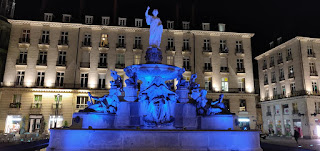The basic
idea behind this Marie Skłodowska-Curie funding for ITN projects is they employ
a foreign researcher and have international collaborations within academic and industry;
this will bring ideas to host institute as well as visiting institute. This is
based on experience of Madam Marie Skłodowska-Curie who was from Poland and
conducted a pioneering research in the field of radioactivity. She was the
first woman to win Nobel price and first person to win Nobel price twice, so is
also the name of funding based on her and based on concept of travel and
collaborations internationally.
Following
expectations from EU funding, this project demanded a lot of international
travel all along three years of PhD, which includes visit to 11 places in seven
countries for a total duration of almost more than eight months out of Aalborg University
in the span of three years:
1.
Three secondments
a.
EPFL, Lausanne, Switzerland
(Oct, 2017- Jan, 2018)
b.
BAM, Berlin, Germany
(August, 2018- Sept, 2018)
c.
COWI A/S, Copenhagen,
Denmark (March, 2019- April, 2019)
2.
Three training weeks (to
improve knowledge of ESRs)
a.
BAM, Berlin, Germany (March
2017)
b.
EPFL, Lausanne, Switzerland
(November 2017)
c.
AAU, Aalborg, Denmark (June
2018)
3.
Three Implementations days
(to challenge and align ESRs with industry)
a.
BAST, Bergisch Bladbach,
Germany (March 2018)
b.
EFFAGE, Vélizy-Villacoublay,
France (October 2018)
c.
COWI A/S, Copenhagen,
Denmark (June 2019-Planned)
4.
INFRASTAR training school
a.
IFSTTAR, Nantes, France
(April 2019)
5.
Conferences
a.
EAWE, Brussels, Belgium
(Sept 2018)
b.
IALCCE, Ghent, Belgium (October
2018)
c.
ICASP, Seoul, South-Korea
(May 2019, planned)
d.
WESC, Cork, Ireland (June
2019, planned)
Overall
experience was great learning different languages, cuisines, cultures,
histories, way of working, way of thinking also ended up with lot of collaborations
with outcome of research papers, proving the concept of international
collaborations.
Amol

































